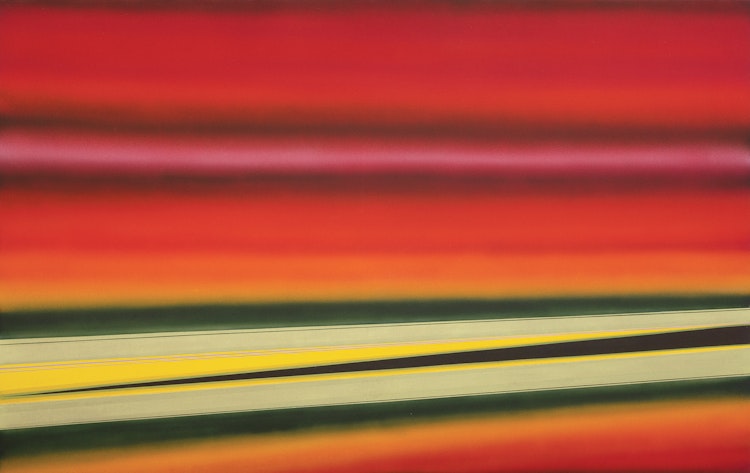Untitled by Rita Letendre

Rita Letendre
Untitled
oil on canvas
signed and dated 1975 lower right; signed (three times) and dated 1975 on the reverse; unframed
42 x 66 ins ( 106.7 x 167.6 cms )
Auction Estimate: $15,000.00 - $20,000.00
Price Realized $28,800.00
Sale date: December 3rd 2020
Galerie Gilles Corbeil, Montreal
Private Collection, Montreal
Joan Murray, “Canadian Art in the Twentieth Century”, Toronto, 1999, pages 99 and 122
Wanda Nanibush and Georgiana Uhlyarik, “Rita Letendre: Fire and Light”, Art Gallery of Ontario, 2017, pages 17-19
Having shifted towards this more plastic realm of art, Letendre distinguished herself as a unique tour de force. Joining the Non- Figurative Artists’ Association in Montreal in 1956, this group fundamentally helped shape her development as an artist. Preferring the moniker of Non-Figurative rather than Abstract artists, this helped distinguish the artists apart from European counterparts exploring geometric abstraction as well as taking the teachings of the Automatistes a step further. Throughout the 1970s, Letendre focused her practice on exploring speed and vibration through her works. Joan Murray discusses, “Rita Letendre explored colour, line and composition through the use of forceful chevrons that cut across the composition diagonally or horizontally from one corner of the painting to the other. She obtained extra energy from applying narrow ridges of contrasting colour to the borders of each ray.”
Wanda Nanibush argues that “No label fits Letendre perfectly, as her influences have been drawn from diverse movements and tendencies. She belongs to the romantic tradition because of her focus on the evocative qualities of light and colour, which were categorically rejected by Les Plasticiens. However, influenced by Les Plasticiens, Letendre has maintained an interest in the ‘plastic’, or formal, elements of painting.” The selection of deep oranges, magenta and bright yellow colouring the composition in sharp wedges and airbrushed bands explode off the canvas and wrap the viewer in glowing energy. The amalgamation of influences and experimentations are expertly harnessed in “Untitled” and stand as a fiery example of the artist’s most celebrated period of work.
Share this item with your friends
Rita Letendre
(1928 - 2021) RCA
Canadian painter, muralist, and printmaker Rita Letendre was born in Drummondville, Quebec, in 1928. She is of Iroquois descent. Letendre and her parents moved to Montreal in 1941. She settled in Toronto in 1963. In part, Letendre is self-taught but she studied at the Ecole des Beaux-Arts in Montreal for year and a half. While in school she was introduced to the Automatistes due to pamphlets announcing the locations of their new paintings.
Encouraged by Borduas, Mosseau, and Ferron’s art, Letendre began exploring similar motifs in her paintings and began exhibiting with the group from 1952-55. In 1955 she exhibited in “Espace 1955” at the Montreal Museum of Fine Arts. Sharing a studio with fellow Automatiste painter and sculptor, Ulysse Comtois, Letendre became the subject of an article by the Weekend Magazine on non-objective Montreal-based painters. Then, in 1959, Letendre was included in the Third Biennial Exhibition of Canadian Art. In the following year the National Gallery of Canada included Letendre in their Non-Figurative Artists of Montreal exhibit that traveled throughout Canada. In 1962, Letendre received a travelling grant from the Canada Council and traveled to Paris, Italy, Israel, Spain, Belgium, and Germany.
Using a variety of techniques and media such as brush, spatula, pastel, silkscreen, and airbrush, Letendre was a leading member of the colourist movement. Exhibited in over sixty-five solo exhibitions, Letendre’s work can be described in three distinct periods. Her first period, known as the Montreal years, was inspired by her first meeting with Borduas and was a rich exploration of self-discovery. Letendre’s second period was inspired by Russian-born sculptor Kosso Eloul, who later became her husband. Her final period was rooted in mourning and love.
Letendre’s works vary in size from grand murals that are sixty feet by sixty feet in size to small projects on silkscreen. These works are collected throughout the North American continent by governments and public and private galleries and organizations. Letendre’s work has been exhibited in Europe, Israel, Japan, and throughout North America in New York City, Los Angeles, San Francisco, Detroit, Montreal, Toronto, and Vancouver.
Literature Sources:
"A Dictionary of Canadian Artists, Volume II”, compiled by Colin S. MacDonald, Canadian Paperbacks Publishing Ltd, Ottawa, 1979
Roumanes, Jacques-Bernard. “Rita Letendre: Le tableau ivre.” Vie des Arts 45, 183, 2001
Andersen, Marguerite. “Rita Letendre: Énergie et luminosité. L’art du féminin, 12 2004
We extend our thanks to Danie Klein, York University graduate student in art history, for writing and contributing this artist biography.

